There’s always a moment whenever I go to any museum that I reach a saturation point. This is the time when I’m simply looking at whatever is displayed but not thinking about it. Some have a longer intake allowance than others and the Darwin Military Museum was, as would any military museum be for me, among those for which I have a shorter tolerance. I saw more pain and destruction than I needed to see and took a short ice cream break in the museum’s cafe while waiting for my fellow Road Scholars to finish their visit.
It was a short ride for our short visit to the Museum and Art Gallery of the Northern Territory and, while I found the exhibit about the Arnhem Land Progress Aboriginal Corporation particularly interesting and informative, I hadn’t yet fully recovered from the previous museum’s emotional and museum fatigue and retained very little. My photo album has only three pictures from this site including this one of Sweetheart the estuarine crocodile (I’d left my camera on the coach because I think we’d been incorrectly told that photos weren’t allowed. Unfortunately, those I took with my phone were generally terrible. I also think I had some lingering museum fatigue).
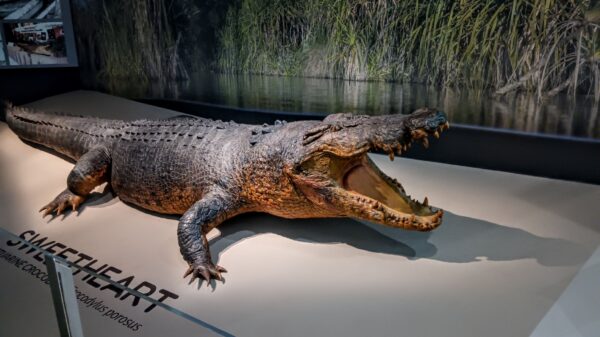
So, instead of telling you about the MAGNT, I’ll tell you about
The second 20th century devastation of Darwin.
As seen in the previous post, much of Darwin was leveled in both the initial Japanese bombing raids on 19 February 1942 and the ongoing 21 months of air attacks by the Japanese Air Force. But the war ended on 15 August 1945 and the Australians had allied themselves with the winning side. This meant that rebuilding and regrowth could begin.
A decade later the substantial investment by the central government in all of the Northern Territory but especially in and around Darwin combined with accelerating immigration not only restored the city of Darwin but made it a vibrant and growing one. Mining, defense, a resurgent pearl industry and tourism saw the city’s population boom from less than 3000 in 1947 to more than 40,000 by 1975. Darwin became one of Australia’s most multicultural cities and, perhaps more importantly, life seemed normal.
Bouncing me off the ceiling
In the northern hemisphere, we have hurricanes. In the southern hemisphere they have cyclones. Cyclones making landfall along the northern coast of Australia are unusual. Since its settlement, Darwin had been struck twice by major cyclones – once in 1897 and again in 1937. But in those days it was a much smaller community.
Then came Christmas morning in 1974 and the arrival of Tropical Cyclone Tracy.
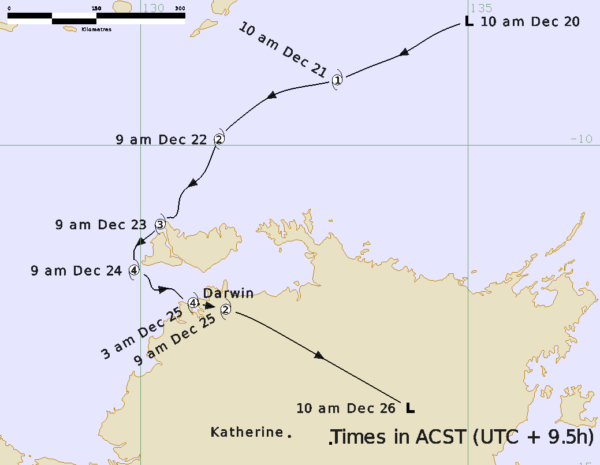
[From Australian Bureau of Meteorology]
By noon on Christmas Eve, it was clear that Darwin would be in the direct path of the storm. Perhaps because of the day or previous “false alerts”, most of the warnings from the Australian Bureau of Meteorology went unheeded. And Tracy continued its march.
Three characteristics of these storms can be impactful – wind, rain, and storm surge. By cyclonic standards, Tracy was a rather small Category 4 storm. The radius of its gale force winds (average greater than 63kph) was a mere 50 kilometers. (The range for a typical storm of this type would be 300-500 km.) Similarly, it dropped a mere 280 mm of rain in 24 hours whereas a typical storm might have rainfall of more than 400 mm. But by the time Cyclone Tracy had passed over Darwin, more than 70 people had died and more than 80% of its buildings were damaged or destroyed.
Two factors conspired to make the storm so devastating – wind speed and slow movement. The storm made landfall with sustained winds estimated at 205 kph with at least one gust surging to 217 kph – the highest ever recorded on the Australian continent to that date – before it broke the airport’s anemometer. A typical cyclone will race along at speeds between 16 and 24 kph. At 6 kph Tracy had effectively slowed to a crawl and you can see the result in the video above. Once again, the city had to rebuild from scratch.
By 1984, it looked like this.
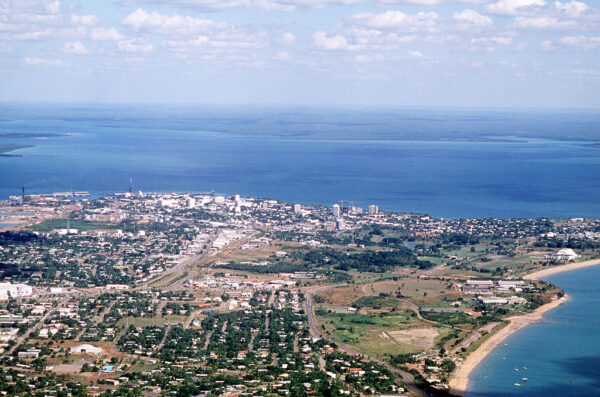
[From US Air Force – Public Domain]
And today, a city with a population near 140,000 and built with much higher construction standards, though seen from a different angle from the photo above, looks like this.
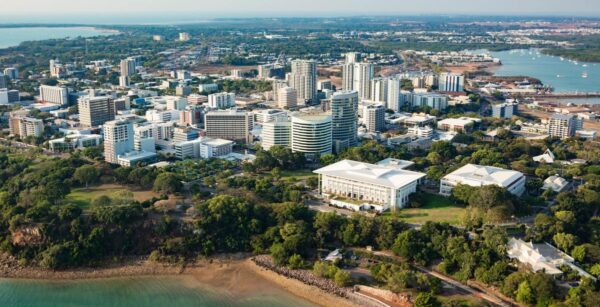
[From Activate Darwin]
On a very short walkabout
(Far away in another life I walked my land proud and free.)
If I’ve ever misused a term, this is it. Australian English adopted the term in the 19th century during which westernized Aboriginal Australians migrated into the bush. (Often this happened during the wet season when cattle station work was scarce.) Individuals used this time to reconnect with cultural traditions and family. But the roots go even deeper. In many First Peoples cultures, young males are sent into the wilderness as a rite of passage in which they make a spiritual and traditional transition into manhood.
I did none of that on our free afternoon in Darwin. I simply wandered around the area relatively close to our hotel seeking out Darwin’s street art some of which was (to my eyes) stunning

and some was a bit cheeky.
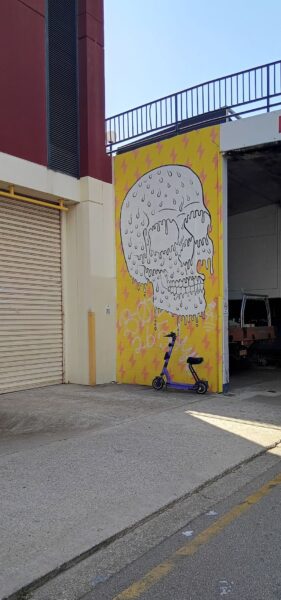
The sweating skull was more than appropriate on this day with temperatures in the low forties and with significant humidity to go along with it.
While I’m defining terms, let me take you on a trip that differentiates between the Outback and the bush. In Australia, nearly everyone lives near (or even in) the bush. Practically no one lives in the Outback. For example, even a place like the Royal National Park an hour or so from Sydney has places that could be considered bush. Take a look at this map of the Outback from Pew Trust.
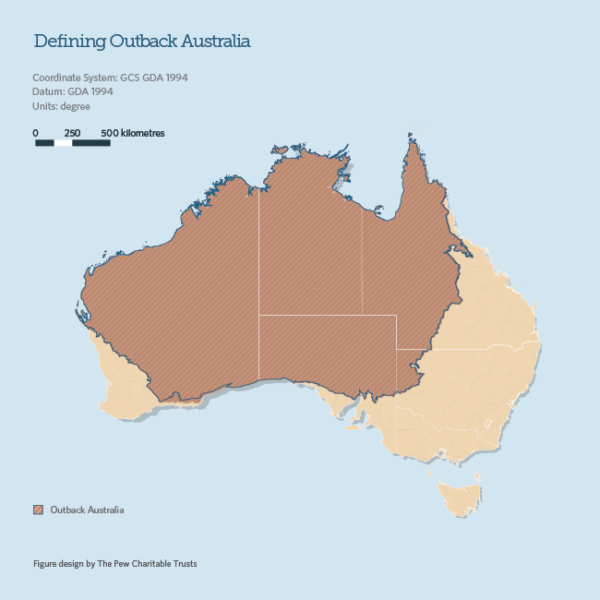
Now recall that 70 percent of Australia’s population lives within 50 kilometers of the coast. The Outback’s 5,600,000 km² is about half the size of the United States with a population of a mere 1,350,000.
Here’s how Alexander Moller explains it.
CHOW!-ing down
Sweating profusely, I returned to my hotel room to freshen up before dinner only to find Gideon’s Bible and a non-functioning shower and toilet. When I reported it to the desk I learned that mine was in a column of two rooms that were affected. The young woman at the desk said they hoped to have the problem fixed soon and suggested I check back after dinner.
Unless you remember my comment above that Darwin is exceptional in its multiculturalism you might be surprised to learn that it’s considered the laksa capital of Australia. If you want to raise a good debate in Darwin, assert your claim as to where to find the best laksa. I was told that feelings about this Malaysian originated Southeast Asian noodle soup are so strong in Darwin that these debates often rival those on politics or religion.
We probably couldn’t have gone too far wrong with any of the well-know spots but I chose CHOW! because it had stellar reviews online and was about a 20-minute walk along the Esplanade from the hotel. D and I set off at a leisurely pace. We shared a small plate of rice paper rolls followed by two bowls of laksa that we didn’t share. Hers was duck. Mine was seafood. Both were scrumptious. And we had another lovely sunset
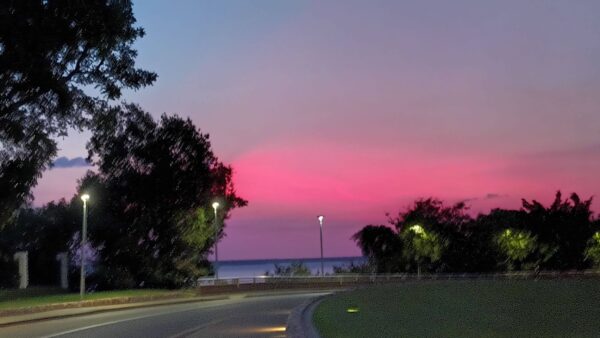
on our return walk.
As for the hotel, they hadn’t fixed the problem and I have to give kudos to the young woman who was working at the desk because, although I wasn’t among them, I feel fairly certain she had to deal with more than one agitated guest. Fortunately, she found me a different room and I was finally able to take that long awaited shower.
Here’s your link to the day’s other photos. Tomorrow we board the Ghan and start for Alice Springs.
That was Nov. 12, John’s birthday, celebrated at the museum cafe with the RS group for lunch. Several people had birthdays during the trip and received cute gift bags that included soap made by E. Thoughtful remembrances. We went to dinner at an Italian restaurant and it wasn’t very good!!
I remember John’s birth anniversary day. I wish you all had come along with D & I to Chow! At least he would have had a good celebratory dinner.
Hindsight is always 20/20.